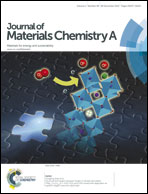N-phenyl[60]fulleropyrrolidines: alternative acceptor materials to PC61BM for high performance organic photovoltaic cells†
Abstract
A series of novel soluble [60]fulleropyrrolidine derivatives bearing relatively simple substituents like [6,6]-phenyl-C61-butyric acid methyl ester (PC61BM) is synthesized under Prato reaction conditions. The photoabsorption and electrochemical properties of the fulleropyrrolidines are investigated to elucidate their molecular-level electronic properties similar to those of PC61BM. The investigations of the fulleropyrrolidines as electron acceptors based on bulk-heterojunction type organic photovoltaic (OPV) devices fabricated using P3HT as a donor show clear differences in performance depending on the substituents, and the devices based on the N-phenyl[60]fulleropyrrolidine derivatives exhibit good power conversion efficiencies (PCEs) comparable to, or even higher than, that of the standard PC61BM-based device. Finally, the OPV devices based on a low-bandgap donor polymer (PTB7) with the N-phenyl[60]fulleropyrrolidines show high PCEs up to 7.3%, which is the highest class performance among [60]fullerene-based OPV devices, indicating that N-phenyl[60]fulleropyrrolidine derivatives are a promising alternative to PC61BM for OPV acceptor materials.
![Graphical abstract: N-phenyl[60]fulleropyrrolidines: alternative acceptor materials to PC61BM for high performance organic photovoltaic cells](/en/Image/Get?imageInfo.ImageType=GA&imageInfo.ImageIdentifier.ManuscriptID=C4TA04857A&imageInfo.ImageIdentifier.Year=2014)

 Please wait while we load your content...
Please wait while we load your content...